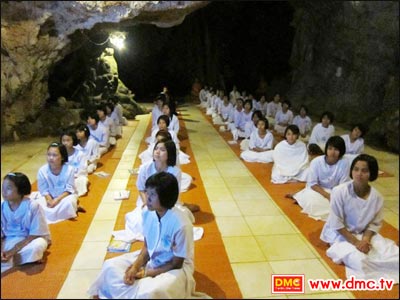Meditation for Beginners
The Noble Eightfold Path on the Mundane Level # 6
Avoidance of evil not yet done
6. Right Effort
Right Effort is composed of the Four Foundations of Effort, namely:
1. Avoidance of evil not yet done [samvara-padhana];
2. Abandonment of evils already done [pahana-padhana];
3. Development of virtues not yet done [anurakkhana-padhana]
4. Maintainance of virtues already masterd [anurakkhana-padhana]
6.1 The First Foundation of Effort
The first foundation of effort is to avoid evils not yet done. This is well illustrated by the example of the bodhisattva in the Mora Jataka (J.159, J.491):
The bodhisattva was once born as a golden a golden peacock with a body the size of a cart and eyes like bright red berries and its mouth pink like coral. The bird had a red aura too. Noticing his own beauty in the reflection of a pond, he realized the risk of continuing to live near the haunts of men so he fled secretly from the flock at noght to the Himavanta forest, finding safe cave as a home on a golden hill in Dandaka. Every morning he would recite a mantra in honour to the rising sun (with the words “ ahetayancakkuma ekaraja harissavanna..”. Every evening he would recite a spell in honour to the setting sun (with the words “ appetayancakkhuma ekaraja harissavanno…” and thus was protected from all harm. In this way he maintained an unbroken practice for 700 years.
This is an example of Right Effort on the worldly level aris ing from wholesome intention.
Avoidance of evil not yet done
6.2 The Second Foundation of Effort
The second foundation of effort is to abandonment of evils already done. This is well illustrated by the example of the bodhisattva in the Panca-Uposatha Jataka (J.490). At that time the bodhisattva was born in a wealthy Brahmin family. However, he renounced the wealth and became a hermit in an amenable location near to Magadharasthra. Near to his hermitage lived many sorts of animals. Pigeons lived in the nearby bamboo. A snake lived in a termite mound. There were also a jackal and a bear.
One day the cock pigeon went foraging and while he was gone his mate was killed by a hawk. The cock returned and was overcome by remorse and yearning for his mate. Thus the pigeon entered the hermitage to keep Eight Precepts in order to still his troubled mind. The pigeon took the vow that he would not go foraging any more for as long as he could not still his mind from desire.
The snake had been trodden upon by a “holy cow” and had bitten the cow, accidentally killing it. When the cowherd found the cow dead, he broke into tears. After performing the necessary rites, the cowherd buried the cow close by the snake’s termite mound. Seeing this, the snake became disgusted at his own uncontrolled anger. Thus the snake entered the hermitage taking the vow never to hunt again until he could overcome his anger.
The jackal had once been out scavenging and, coming across the dead body of an elephant, ate into it from behing and lived inside it. When the body dried up, he became a prisoner and made frenzied efforts to escape. Eventually the storm broke, moistening the hide and allwing him to emerge through the head, but not without losing all his hair as he crawled through. He thereupon resolved to renounce his greediness. Thereupon he entered the hermitage with the other animals (also J.148).
The second foundation of effort is to abandonment of evils already done.
The bear had been greedy for fancy food and had left the safety of the forest ot enter the town in search of dainties. On entering the village the bear had received many ties. On entering the village the bear had received many blows before fleeing. Reflecting on his injuries, the bear saw that his own stupidity was the reason for his hurt and resolved to enter the hermitage, not to re-emerge until he could overcome his delusion.
The hermit himself had once suffered from arrogance about being ‘born of the Brahmas’. With such arrogance, he had not been able to attain the meditative absorptions. A Paccekabuddha saw the hermit’s potential for enlightenment and went to where the hermit was, appearing before him floating in the air. However, the hermit was so full of pride that he paid no respect. The Paccekabuddha thus advised him:
“I am a Paccekabuddha. As for you, who will go on to be a fully-enlightened Buddha why are you so afflicted by arrogance? Arrogance does not befit you.”
However, the hermit still did not humble himself. Thus the Paccekabuddha continued:
“As a Paccekabuddha, my attainment is by far superior to yours. If you doubt it, why don’t you try floation in the air like me?”
The paccekabuddha rose in the air and floated away to the Himavanta forest. Consequently, the hermit was so humiliated that he realized he must devote himself to serious practice. He felt ashamed of his arrogance. Therefore, he took Eight Precepts and vowed not to go out to pick fruit again until by meditation he could overcome his False Views.
Thus the pigeon practiced to overcome lust, the snake to overcome anger, the jackal to overcome greed, the bear to overcome delusion and the hermit to overcome his arrogance. All these five sorts of practice are making effort representative of the second category of Right Effort on the worldly level arising from wholesome intention.
Development of virtues not yet done
6.3 The Third Foundation of Effort
The third foundation of effort is the development of virtues not yet done [bhavana-padhana]. There is an incident related in the Dhammapada which illustrates this sort of effort:
Once there was a brahmin who noticed tha as the monks stopped at a certain place to robe themselves before entering the town for alms, the hems of their robes would always become wet from the dew on the grass. Therefore the wholesome intention arose in his mind to do a good deed he had never done before that is, to cut the grass at the point where the monks habitually robed themselves. Thinking thus, he cut the grass. Some time later, the same Brahmin observed the monks robbing themselves at the same spot at midday and noticed that the hems of the monks’ robes was getting soiled by dust on the ground. Therefore he had the wholesome intention to cover up the dust with clean sand and thinking thus he obtained sand and covered over the dust at that spot. Later still, not contented with the good deeds he had already done, he noticed that standing in the sun to robe oneself caused the monks to sweat profusely or when it was raining, caused the whole robe to become soaked. Therefore he built a small pavilion was completed, he invited the Buddha and the monastic community to take a meal in the pavilion. When the Buddha heard about the brahmin’s wholesome efforts, he gave the teaching:
“Just as a goldsmith must smelt gold not one time, but many times before it can be used to make jewelry, in ordert o remove all the impurities from the metal, the wise who wish to remove the defilements from their mind (such as greed etc.), must remove those impurities little by little, sequentially until none remain, while at the same time cultivation wholesome deeds constantly,”
Hearing the Lord Buddha’s explanation, the Brahmin attained “Stream-Entry”.
This is an example of making effort representative of the third category of Right Effort on the worldly level arising from wholesome in tention.
Maintainance of virtues already masterd
6.4 The Fourth Foundation of Effort
The fourth foundation of effort means the maintenance of virtues already mastered [anurakkhana-padhana]. There virtues already mastered [anurakkhana-padhana]. There is an incident related in the Scriptures about 500 laymen who at first persuaded one another to keep the Five Precepts. Having accomplished that, next time round they persuaded one another to keep the Eight Precepts. Next time round they persuaded each other to keep the Ten Precepts and the time after that, to ordain as novices in the monastic ommunity. Eventually, having all trained themselves in the necessary manners and knowledge, they all became fully-ordained monks.
This is an example of making effort representative of the fourth category of Right Effort on the worldly level arising from wholesome in tention.
Meditation - Related Articles
" />
" />
" />
" />
" />
" />
" />
" />
" />
" />
" />
" />










